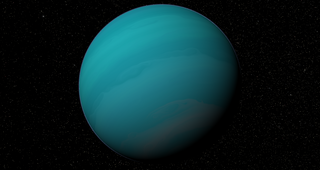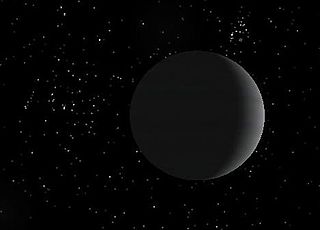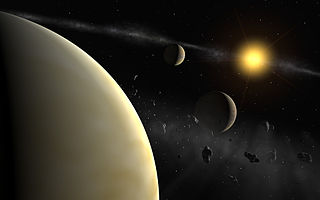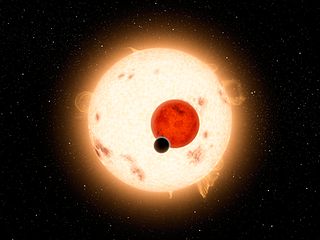Related Research Articles
Mu Arae, often designated HD 160691, officially named Cervantessur-VAN-teez, is a main sequence G-type star approximately 50 light-years away from the Sun in the constellation of Ara. The star has a planetary system with four known extrasolar planets, three of them with masses comparable with that of Jupiter. Mu Arae c, the innermost, was the first hot Neptune or super-Earth discovered.

In astronomy and astrobiology, the circumstellar habitable zone (CHZ), or simply the habitable zone, is the range of orbits around a star within which a planetary surface can support liquid water given sufficient atmospheric pressure. The bounds of the CHZ are based on Earth's position in the Solar System and the amount of radiant energy it receives from the Sun. Due to the importance of liquid water to Earth's biosphere, the nature of the CHZ and the objects within it may be instrumental in determining the scope and distribution of planets capable of supporting Earth-like extraterrestrial life and intelligence.

An exomoon or extrasolar moon is a natural satellite that orbits an exoplanet or other non-stellar extrasolar body.

Planetary habitability is the measure of a planet's or a natural satellite's potential to develop and maintain environments hospitable to life. Life may be generated directly on a planet or satellite endogenously or be transferred to it from another body, through a hypothetical process known as panspermia. Environments do not need to contain life to be considered habitable nor are accepted habitable zones (HZ) the only areas in which life might arise.

HD 28185 b is an extrasolar planet 128 light-years away from Earth in the constellation of Eridanus. The planet was discovered orbiting the Sun-like star HD 28185 in April 2001 as a part of the CORALIE survey for southern extrasolar planets, and its existence was independently confirmed by the Magellan Planet Search Survey in 2008. HD 28185 b orbits its sun in a circular orbit that is at the inner edge of its star's habitable zone.

Gliese 876 b is an exoplanet orbiting the red dwarf Gliese 876. It completes one orbit in approximately 61 days. Discovered in June 1998, Gliese 876 b was the first planet to be discovered orbiting a red dwarf.

Mu Arae b, often designated HD 160691 b, formally named Quijote, is an exoplanet orbiting the star Mu Arae of the constellation Ara.

HD 69830 d is an exoplanet likely orbiting within the habitable zone of the star HD 69830, the outermost of three such planets discovered in the system. It is located approximately 40.7 light-years (12.49 parsecs, or 3.8505×1014 km) from Earth in the constellation of Puppis. The exoplanet was found by using the radial velocity method, from radial-velocity measurements via observation of Doppler shifts in the spectrum of the planet's parent star.

A Super-Earth is a type of exoplanet with a mass higher than Earth's, but substantially below those of the Solar System's ice giants, Uranus and Neptune, which are 14.5 and 17 times Earth's, respectively. The term "super-Earth" refers only to the mass of the planet, and so does not imply anything about the surface conditions or habitability. The alternative term "gas dwarfs" may be more accurate for those at the higher end of the mass scale, although "mini-Neptunes" is a more common term.

The habitability of natural satellites describes the study of a moon's potential to provide habitats for life, though is not an indicator that it harbors it. Natural satellites are expected to outnumber planets by a large margin and the study is therefore important to astrobiology and the search for extraterrestrial life. There are, nevertheless, significant environmental variables specific to moons.
HD 40307 c is an extrasolar planet orbiting the star HD 40307, located 42 light-years away in the direction of the southern constellation Pictor. The planet was discovered by the radial velocity method, using the HARPS apparatus, in June 2008. Of the six proposed planets in the HD 40307 star system, it is the third-largest, and has the second-closest orbit from the star. The planet is of interest as this star has relatively low metallicity, supporting a hypothesis that different metallicities in protostars determine what kind of planets they will form.
HD 153950 b, also known as Trimobe, is an extrasolar planet located approximately 162 light-years away. This planet was discovered on October 26, 2008 by Moutou et al. using the HARPS spectrograph on ESO's 3.6 meter telescope installed at La Silla Observatory in Atacama desert, Chile.

An exoplanet is a planet located outside the Solar System. The first evidence of an exoplanet was noted as early as 1917, but was not recognized as such until 2016; no planet discovery has yet come from that evidence. What turned out to be the first detection of an exoplanet was published among a list of possible candidates in 1988, though not confirmed until 2003. The first confirmed detection came in 1992, with the discovery of terrestrial-mass planets orbiting the pulsar PSR B1257+12. The first confirmation of an exoplanet orbiting a main-sequence star was made in 1995, when a giant planet was found in a four-day orbit around the nearby star 51 Pegasi. Some exoplanets have been imaged directly by telescopes, but the vast majority have been detected through indirect methods, such as the transit method and the radial-velocity method. As of 1 September 2023, there are 5,506 confirmed exoplanets in 4,065 planetary systems, with 878 systems having more than one planet. This is a list of the most notable discoveries.

Kepler-16b is an exoplanet. It is a Saturn-mass planet consisting of half gas and half rock and ice, and it orbits a binary star, Kepler-16, with a period of 229 days. "[It] is the first confirmed, unambiguous example of a circumbinary planet – a planet orbiting not one, but two stars," said Josh Carter of the Center for Astrophysics | Harvard & Smithsonian, one of the discovery team.
HD 192310 b is an exoplanet orbiting the star HD 192310. It orbits its parent star with a semimajor axis of 0.32 ± 0.005 AU, an eccentricity of 0.13 ± 0.04. and an orbital period of 74.72 days.
HD 38858 is a G-type star, much like The Sun, with one detected planet. The planet, designated HD 38858 b, is about twice the mass of Uranus and orbits in the star's habitable zone.

Kepler-90h is an exoplanet orbiting within the habitable zone of the early G-type main sequence star Kepler-90, the outermost of eight such planets discovered by NASA's Kepler spacecraft. It is located about 2,840 light-years, from Earth in the constellation Draco. The exoplanet was found by using the transit method, in which the dimming effect that a planet causes as it crosses in front of its star is measured.

Kepler-1647b is a circumbinary exoplanet that orbits the binary star system Kepler-1647, 3,700 light-years (1,100 pc) from Earth in the constellation Cygnus. It was announced on June 13, 2016, in San Diego at a meeting of the American Astronomical Society. It was detected using the transit method, when it caused the dimming of the primary star, and then again of the secondary star blended with the primary star eclipse. The first transit of the planet was identified in 2012, but at the time the single event was not enough to rule out contamination, or confirm it as a planet. It was discovered by the analysis of the Kepler light-curve, which showed the planet in transit.
HIP 57274 d is an exoplanet orbiting the K-type main sequence star HIP 57274 about 84.5 light-years (26 parsecs, or nearly 8.022×1016 km) from Earth in the constellation Cetus. It orbits within the outer part of its star's habitable zone, at a distance of 1.01 AU. The exoplanet was found by using the radial velocity method, from radial-velocity measurements via observation of Doppler shifts in the spectrum of the planet's parent star.
References
- ↑ Pepe, F.; et al. (2011). "The HARPS search for Earth-like planets in the habitable zone: I – Very low-mass planets around HD20794, HD85512 and HD192310". Astronomy & Astrophysics. 534: A58. arXiv: 1108.3447 . Bibcode:2011A&A...534A..58P. doi:10.1051/0004-6361/201117055. S2CID 15088852.